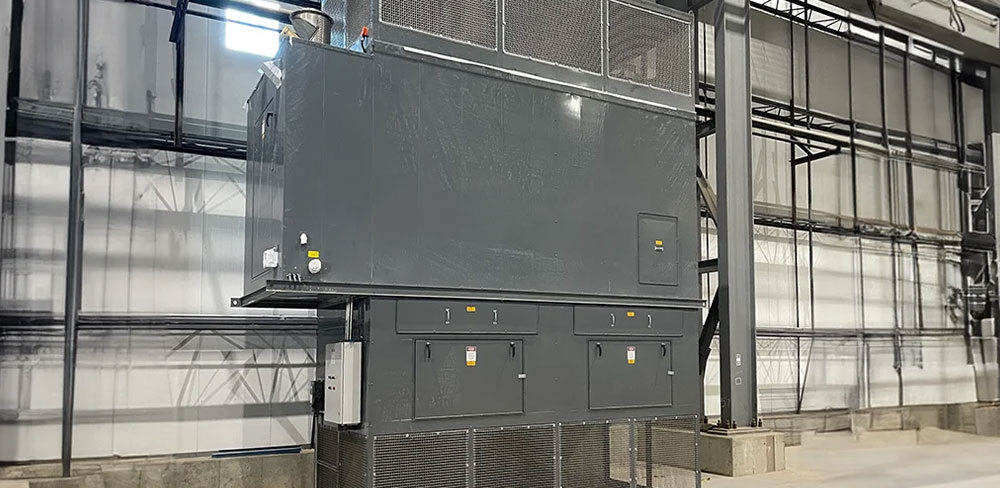Winter’s Effect on Industrial Ventilation Requirements
Proper ventilation is just as important in colder weather as it is in higher temperatures to ensure optimal indoor comfort and air quality. As temperatures plummet, doors, windows, and service bays close up to block out the cold and snow. However, this also cuts off the supply of fresh air, leading to a number of problematic consequences. Expertly designed ventilation solutions ensure adequate airflow, helping provide a more comfortable and healthy winter work environment.
Air Quality and Worker Health
Closing industrial and commercial buildings for the winter, without providing adequate ventilation, can lead to a drastic reduction in indoor air quality. Workers are then exposed to higher concentrations of airborne pathogens, such as the cold, flu, and COVID-19 viruses. Proper ventilation will maintain internal airflow, reducing pathogen concentration. When paired with HEPA air filtration, ventilation systems can further protect workers from winter illness. In fact, following the COVID pandemic, OSHA issued a worker safety alert explaining the importance of industrial ventilation systems during winter.
Hazards of Humidity
Winter weather is notorious for creating conditions that allow condensation to accumulate on cooler surfaces, such as floors, windows, shelving, and equipment. As condensation accumulates, it can drip down the walls and ceilings, causing hazardous working environments and damaging insulation, drywall, equipment, materials, and products. Excessive humidity also encourages fungal and bacterial growth, which can result in increased worker illnesses.
Adequate winter ventilation is particularly important in moisture-producing processes. If this moisture is not exhausted from the building, it can cause condensation on the roof and walls. Removing the moist air with roof exhaust fans and replacing it with dry, heated air, can prevent this condensation build-up and moisture damage.
Industrial Ventilation’s Role in Temperature Regulation

Even in colder weather, heat-producing operations, such as glassworks and forges, can create enough heat to elevate internal temperature above safe working limits. Proper industrial ventilation throughout the year is critical in these situations to protect workers from heat-related illnesses. In cold weather climates, the right industrial ventilation solution will keep a building warm too. The right ventilation solutions can also help reduce energy requirements by optimizing airflow and pulling hot air from higher elevations using Air Turnover Units and makeup air.
Adding additional heating units can also further improve workplace comfort. In very cold buildings ventilation systems will need to heat incoming air to ensure comfortable working temperatures. Heaters, like Direct Gas Fired Makeup Air Units, are vital for keeping industrial facilities warm enough.
Winter Ventilation and Worker Productivity
As the temperature inside drops due to inadequate heating or poorly designed winter ventilation, worker productivity and accuracy also drop. Skilled workers with cold, stiff fingers may not have the dexterity required to perform their tasks quickly or with precision. This same reduced productivity permeates chilly workplaces, slowing workers down and tanking overall productivity. However, custom ventilation solutions tailored to the cold weather conditions, work processes, and building construction, can keep workers comfortable and productive.
Customized Industrial Ventilation Solutions to Address Cold Weather Requirements
Due to the complexity of cold weather ventilation for industrial applications, optimal ventilation solutions should be customized to the building. Considerations for proper building heating include studying heat-generating processes, worker traffic, and the local climate. Moffitt maintains a team of highly qualified and dedicated ventilation experts. These experts leverage their extensive experience to design optimal ventilation solutions for all climate conditions.
To ensure optimal results, it’s best to have our experts out during the winter months to address cold weather requirements. That way, you can have your new system commissioned in time for next year’s cold snap. Contact us to learn more about winter ventilation and schedule your free site evaluation today.
Recent Posts
- Maximizing Industrial Efficiency: The Role of a Ventilation Exhaust Fan in Industrial Facilities
- Reducing the Impact of Tariffs on Industrial Ventilation
- Conquering Corrugated Heat in Arizona with Custom Plant Ventilation Solutions
- Elevate the Game in 2025 – A Note from John Moffitt.
- 6 Signs That It’s Time to Upgrade Your Industrial Ventilation
Categories
- CFD Modeling (17)
- Commercial Ventilation (28)
- Cost Savings (28)
- Energy Savings (36)
- Evaporative Cooling (12)
- Green Ventilation (25)
- Heating (16)
- Hybrid Ventilation (7)
- Industrial Ventilation (108)
- Installation (32)
- Lunch & Learn (21)
- Maintenance (22)
- Manufacturing (14)
- Moffitt (37)
- Natural Cooling (16)
- Natural Daylighting (8)
- Natural Smoke Relief (9)
- Natural Solutions (47)
- Natural Ventilation (97)
- Natural Ventilator Maintenance (4)
- Powered Ventilation (44)
- Pressure Gravity System® (10)
- Product Comparison (13)
- Safety (22)
- Science (33)
- Testimonial (11)
- Wall Louvers (13)
